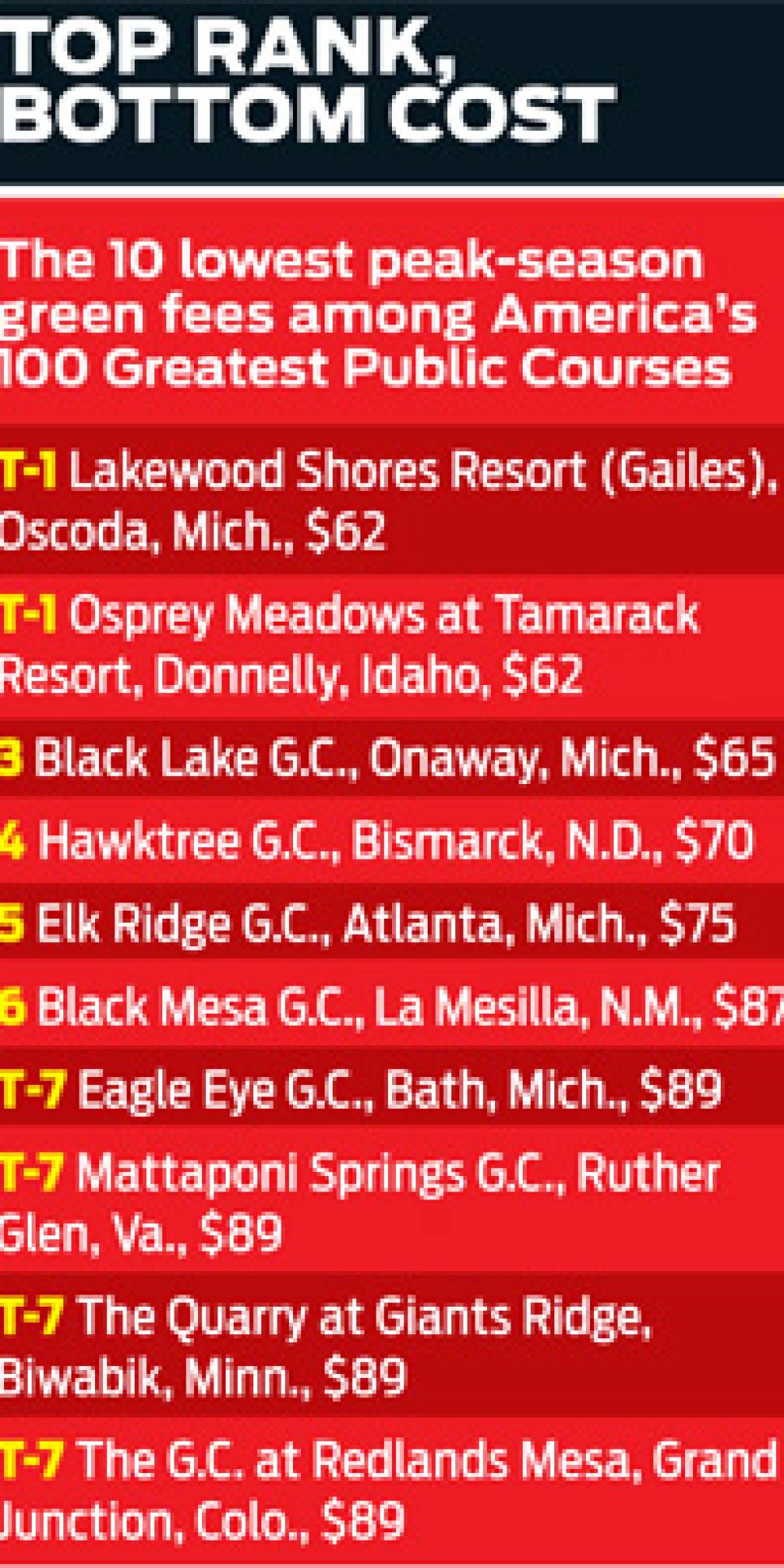The Price Of Greatness

Golf Digest's new ranking of America's 100 Greatest Public Courses
appeared last month and, as usual, some of the honorees will take your breath away. With their green fees, I mean.
Never mistaken for a cheap sport, golf at its highest level can be murderously expensive. The average peak-season weekend green fee at our 100 Greatest Public Courses is $193. Ten charge more than $300, including No. 1-ranked Pebble Beach ($495) and No. 6 Shadow Creek in North Las Vegas ($500).
Thankfully you don't have to pay that much to experience a 100 Greatest Public. Fifteen courses on our latest ranking charge $100 or less in peak season. A few go much lower if you're willing to play on weekdays or in the afternoon. The lowest walk-up rates: $30 for No. 55 World Woods (Pine Barrens) after 3 p.m. in the summer and $30 for No. 64 Pumpkin Ridge (Ghost Creek) after 1 p.m. in the winter.

How does a golf course deliver 100 Greatest Public quality while charging so much less than others on the ranking? Part of it is location. Most of the cheaper courses are in the Midwest and Mountain states, where things generally cost less. But there's more to it than that. I spoke with general managers and directors of golf at a few of these low-cost/high-payoff courses and identified several recurring themes:
Affordability is part of their mission. "We started out wanting to be accessible to all, and we go out of our way to make it so," says Eddie Peck, managing partner of New Mexico's Black Mesa Golf Club. The peak weekend rate at Black Mesa, tied for 86th on our ranking, is $87, but it offers multiple options for paying less, including some package deals with area hotels. Locals can play, walking, for as little as $25.
The trade-off at many of these courses is no-frills, or at least low-frills, compared with other top golf destinations. "Are you going to have swarms of people greeting you when you arrive? No," says Craig Peters, general manager at Michigan's Lakewood Shores, whose Gailes course is tied for No. 88. "And though our rooms are nice, they're not lavish, because we don't go crazy on our rooms. We go crazy on the golf." Inside the modest World Woods clubhouse, you won't find a sit-down restaurant "because they're losers, in our experience," says Director of Golf Stan Cooke. Instead, there's a snack bar -- a much cheaper way of feeding golfers that has the added benefit of keeping them moving.
Which brings up another key point: high volume. World Woods, which hosts about 46,000 rounds a year on its Pine Barrens course, is expert at filling its tee sheets. Golfers who reserve 90 days in advance pay the rack rate. But if World Woods still has openings a week or two from now, it'll send out an e-mail blast with sharply discounted tee times and fill those empty spots. Paying half the rack rate isn't uncommon for golfers who can wait it out (and have some flexibility about when they tee off), Cooke says.
If a course is going to encourage that much play, it'll need a big maintenance budget to keep from turning into a goat track. But there's a difference between good maintenance and over-the-top grooming, something many of the low-green-fee 100 Greatest courses understand. "We're not out there watering 130 acres of turf like some," says Eddie Peck of Black Mesa. "We're fast and firm, lean and mean, and we might not be all that green all the time." Here he laughs heartily. "We're not spending a lot on herbicides and pesticides either."
At all of these courses, a passion for cost control starts at the top. Payroll is a special obsession. World Woods has all but eliminated overtime pay by using a huge crew of retirees as part-time workers. Only a quarter of its 200 employees work full time and get full benefits. Cooke wears multiple hats, serving as general manager of World Woods' two courses and two other private clubs controlled by the same owner. Because Lakewood Shores doesn't have a huge staff, Peters can often be found checking in guests or booking golf packages over the phone. "I'll go and take care of someone's drink order if it needs doing," he says.
Imagine how different the game would be if more top courses were like this. It would be less about flash and more about the joy of golf in an extraordinary setting. I know it's unrealistic to expect most 100 Greatest-level courses to go this route; they have too much invested in their high-end trappings. But at a minimum we can celebrate -- and play! -- the ones that do not.